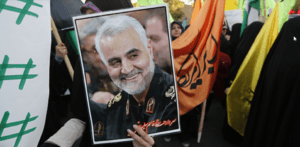What Happened?
Early in the morning of January 3, the United States carried out the targeted assassination at Baghdad Airport of Qassem Suleimani, the head of the Quds Force of Iran’s Islamic Revolutionary Guard Corps, effectively its foreign operations unit. Also killed in the attack was Abou Mahdi al-Muhandis, a leading figure in the Iraqi Popular Mobilization Forces and the head of Kataeb Hezbollah, which the U.S. targeted in air attacks last week, as well as others.
According to U.S. officials quoted by the New York Times, the assassination was authorized by President Donald Trump. The Pentagon declared that “General Suleimani was actively developing plans to attack American diplomats and service members in Iraq and throughout the region.” Iran’s supreme leader, Ayatollah ‘Ali Khamenei was quoted by pro-Iranian media as saying that “all resistance supporters will ask to take revenge for [Suleimani].”
Why Does It Matter?
The Americans had ample reason to kill Suleimani, given that he had spearheaded Iran’s operations against the United States and its allies in the region. Nonetheless, the decision to assassinate him was a remarkable escalation, both against Iran and the Iraqi state. Not only was it carried out at Baghdad airport, humiliating the Iraqis, but in indirectly highlighting that Suleimani came and went as he pleased in Iraq, Washington underlined that the country was a mere playground in the U.S.-Iranian rivalry. That may have been obvious to many people beforehand, but it will have implications for the U.S. presence in Iraq in the future, with the uneasy coexistence there between Iranians and Americans effectively at an end.
Suleimani was also the most public face of Iran’s regional ambitions. He was active from Iraq to Syria to Lebanon to Yemen. Therefore, Iran will be keen to show that his death has not affected its regional plans, and it has a menu of possible responses to the killing. U.S. diplomats, military personnel, and even citizens around the region, not to mention key U.S. allies, may face Iranian retaliation. For Iran, the imperative is to display a strong deterrence capability at a time when the country is facing what it views as unnerving opposition from popular movements in Iraq and to a lesser extent Lebanon, and when its influence in Syria is being quietly challenged by Russia.
The urgency to hit back hard will be especially important at a moment when domestic displeasure with Iran’s regime has never been greater. This has been due primarily to the economic impact of U.S.-imposed sanctions and accusations from many Iranians that their leadership is devoting valuable resources to regional affairs at the expense of its own population. Therefore, by striking hard against the Americans and their partners in the Gulf or Israel, the regime will aim to send a signal at home that the Islamic Republic will not be intimidated into curtailing its regional agenda.
From the perspective of the Trump administration, the message is more uncertain. President Donald Trump has said that he does not want a war with Iran, but in escalating so dramatically he has shown that he is willing to engage in one. This is a continuation of his “maximum pressure” campaign against Tehran, and from a U.S. point of view the idea is to compel Iran to accept Washington’s conditions on curbing its nuclear program and its interference in Arab countries. However, Iran considers its regional sway nonnegotiable, and will increase regional instability to bring that message home.
What Are the Implications for the Future?
We appear to be caught in a logic of war between Iran and the United States, as well as their respective allies. Washington and Tehran may not want it, but by killing Suleimani the Trump administration showed that it was willing to confront Iran’s regional policies, using force if necessary. The only Iranian exit from this situation is to escalate in so sharp a way that it would show the Americans the monumental cost of such a path. Given Donald Trump’s reluctance to go to war with Iran, and his forthcoming reelection campaign, the Iranians are wagering on the fact that the U.S. president’s willingness to push all the way in containing them is, in fact, limited.
However, the Iranian regime will also have to be very careful. Were the Americans, perhaps in coordination with Israel, to organize massive retaliatory strikes on Iran and its economic infrastructure, they could do serious damage to an already vulnerable Iranian economy and rally Arab states opposed to the Islamic Republic. This could create openings for a reduction in Iranian power throughout the Arab world. While Russia and China may back Iran diplomatically, Russian President Vladimir Putin could try to benefit from Iranian reversals by expanding Russian power in the region.
What ensues is likely to be very messy. However, Iran’s preferred method has been to advance its pawns on the margins of Arab states, exploiting their dysfunctional political systems while keeping Iran away from the fray. This has given it a major disruptive capacity on the ground, but has also worried Arab governments that have seen the emergence of pro-Iranian militias outside their control. The attempted destruction of Iran itself may force these governments to take a clearer line against Iran’s methods and regional networks.
We’re not there yet, but Suleimani’s assassination opens many doors that previous U.S. administrations had hesitated to open. Washington and Tehran will have to calculate carefully in what is an explosive new phase in their conflict. Both risk a great deal if something goes wrong, which means it is also possible that they will pull back from the brink in order to avoid a horizon of destructive uncertainty.




